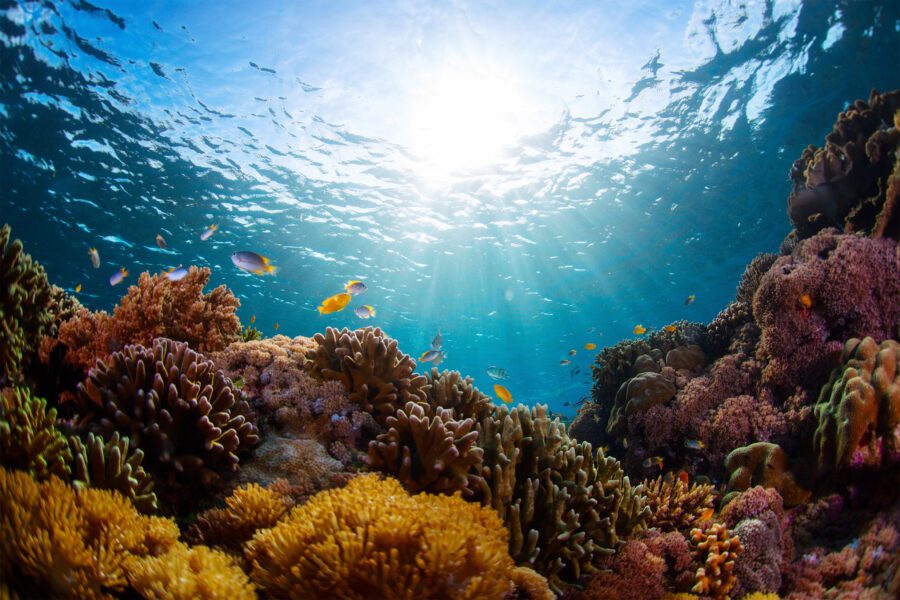
Coral reefs are critical ecosystems on the brink of extinction. Today’s artificial intelligence (AI) and advancements in machine learning have enabled experts to identify, monitor and predict coral health. How do they achieve this? They listen.
The coral reef soundscape
As one of the most biodiverse ecosystems in the world, it’s little wonder coral reefs are bustling with noise. A closer listen will allow one to hear the sounds of shrimps snapping while they forage, parrotfish nibbling on coral polyps or pulsing sounds during breeding. The soundscapes are loud and chaotic and an indication of reef health.
According to doctoral candidate Nadege Aoki from the Woods Hole Oceanographic Institution, a reef thrives when fish and other marine species make a lot of noise. Conversely, it’s more concerning when a reef goes silent — a sign of degradation.
Sound has played an essential role in restoring coral habitats. Aoki and her research team lure coral larvae to degraded reefs using healthy coral reef soundscapes. Their goal is for the larvae to latch on and strengthen the habitat.
The role of machine learning in coral conservation
The ocean covers 71% of the planet, yet humans have only discovered 80%. Thanks to technological advancements, scientists are beginning to understand more about the sea.
Machine learning has been especially crucial in analyzing coral soundscapes. Scientists can train models to recognize patterns and differentiate between healthy and unhealthy reef ecosystems. Although they have taken acoustic recordings at various sites before, developments in machine learning have improved phonic richness for more accurate results and enhanced conservation approaches.
AI applications in coral reef recovery
Machine learning has opened new doors for researchers to understand if coral conservation efforts are working without further obstructing an already fragile ecosystem. Here’s how AI developments are being employed.
1. Identify diseases and threats
Corals are susceptible to various biological and non-biological threats, including multiple diseases. For instance, White Band Disease (WBD), white plague and stony coral tissue loss disease (SCTLD) all result in tissue deterioration. In particular, WBD and SCTLD have spread throughout Caribbean reefs with lethal outcomes.
According to research, WBD has wiped out 95% of Caribbean Acropora since 1979. Scientists use machine learning to identify these biological threats. In one study, machine learning predicted coral diseases with 97% accuracy and recognized 19 bacterial infections, including WBD.
2. Monitor recovery
The Turritopsis dohrnii jellyfish has astounded scientists for its ability to revert to a polyp and start its life over. Essentially, these creatures are immortal. In an ironic twist of events, corals can do it, too.
Research has demonstrated the successful regeneration of fragmented tissue to healthy polyps in the Tubastraea coral genus. While regeneration rates ultimately depend on the fragments’ size and food supply, scientists can study the process to enhance laboratory asexual reproduction and recolonization. Lab-grown corals then get transported to reef sites for restoration.
Sound analysis using machine learning plays a critical role in tracking coral colony recovery. Experts can use several recordings of healthy and dying reefs to train a computer algorithm to recognize the differences. A 2022 study found a 91.7% success rate in identifying healthy reefs, allowing the team to examine progress or deterioration.
3. Predicting health outcomes
Researchers can use machine learning recordings to predict health trends for coral colonies in several ways. For example, they may look for patterns in noise levels and species diversity.
Other identifiable sounds might be seasonal, such as during their breeding cycles or when ocean temperatures fluctuate. Experts should also listen for abnormal sounds, which may indicate conceivable threats to the reef site.
Using these insights, researchers can predict under what conditions the corals thrive or whether their health is declining, including when affected by environmental changes. Machine learning can even simulate future events, such as the potential for coral bleaching during impending heat waves.
Challenges and considerations
As practical as machine learning is, these applications have limitations. The Great Pacific Garbage Patch in the Pacific Ocean has 79 thousand tons of microplastics floating within 1.6 million square kilometers. Unfortunately, this litter can travel to fragile coral reef ecosystems in Hawaii and California.
After studying 84 coral colonies in the Pacific, Atlantic and Indian Oceans, the researchers realized macroplastics accounted for 88% of the debris in deep reefs. Aside from degrading habitat, plastic pollution can contaminate the soundscape with rustling, leading to inaccurate recordings and health monitoring. Noise pollution from vessels and other anthropogenic activity has just as much of a negative impact.
As machine learning evolves, experts may be able to extract specific sounds, reduce noise interference and combine acoustic recordings with other data sets, including satellite imagery, sensor insights and oceanographic measurements. Future engineering could also include attaching machines to buoys for real-time recordings.
Technology paves the way for coral conservation
Restoring coral reefs is essential for environmental, economic, and societal reasons. Therefore, conservation specialists must utilize every resource and technology at their disposal to understand and heal these ecosystems. With machine learning on the rise, their efforts are signaling success.
